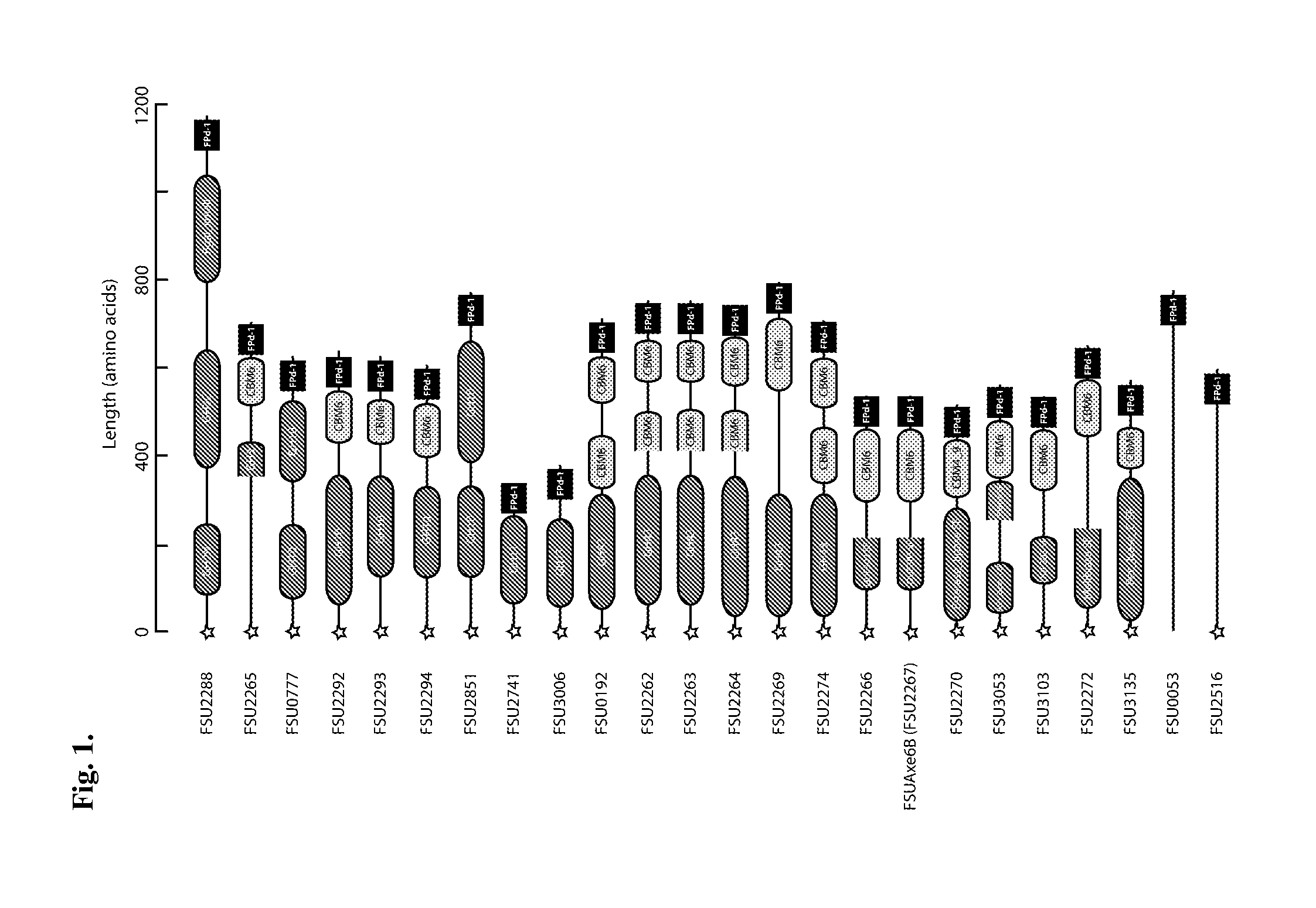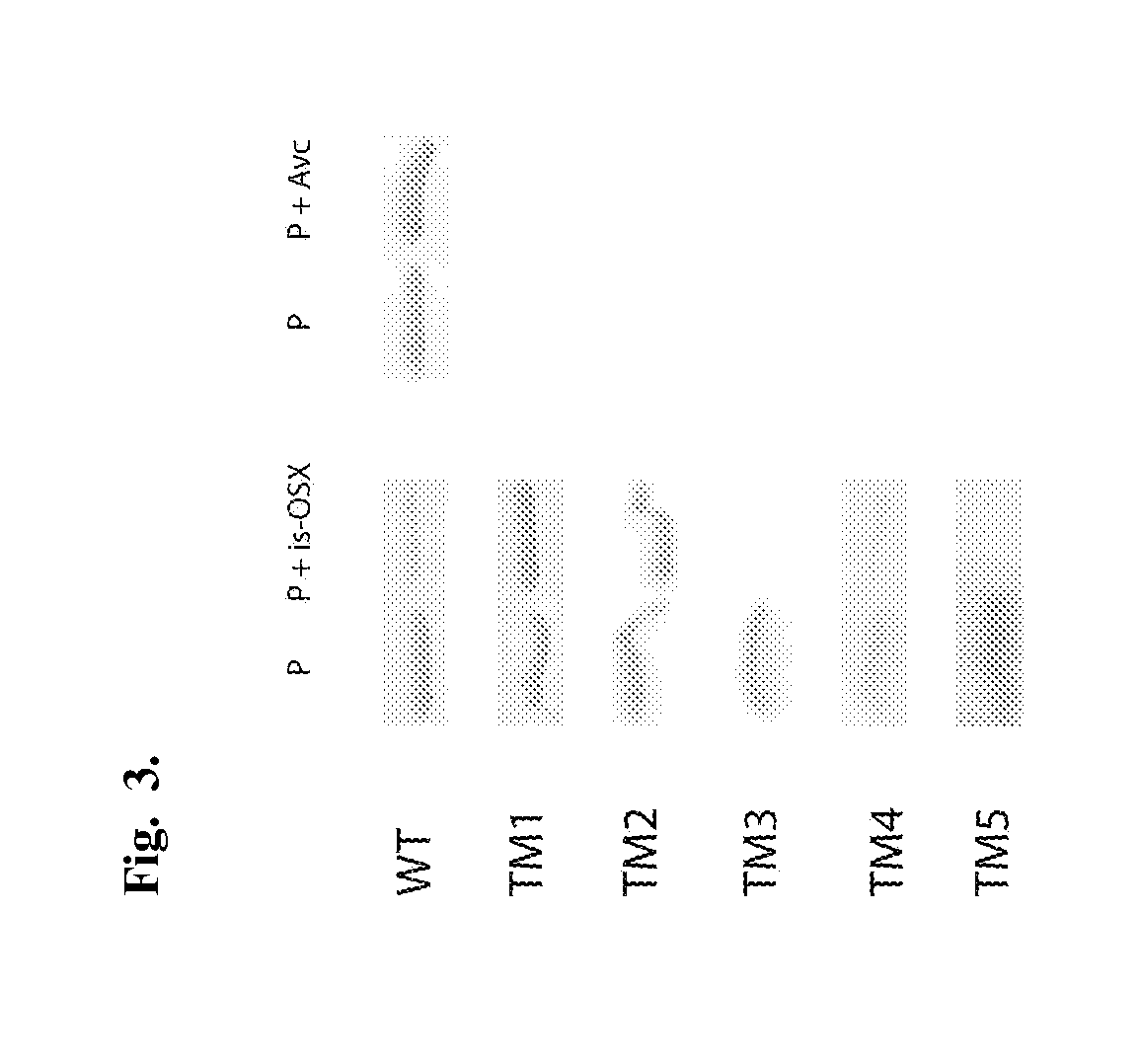Carbohydrate binding module with affinity for insoluble xylan
a carbohydrate and affinity technology, applied in the field of carbohydrate targeting a protein, can solve the problems of lack of highly efficient biocatalysts for the first step, and achieve the effect of increasing the ability of a recombinant protein to bind
- Summary
- Abstract
- Description
- Claims
- Application Information
AI Technical Summary
Benefits of technology
Problems solved by technology
Method used
Image
Examples
example 2
Truncational Derivatives
[0111]To delineate and investigate the modules present in FSUAxe6B for functional role assignments, a gene truncation strategy was adopted. To create the truncated proteins, the glycines in loop regions were selected as the terminal amino acids of our constructs. Based on the secondary structure analysis, five truncational derivatives of the polypeptide, as shown in FIG. 2A, were made. The construct TM1 (CE6+CBM6) was designed to investigate the contribution of FPd-1 to the wild-type (WT) protein in terms of its catalytic (esterase) and carbohydrate binding activities. Likewise, TM2 (CE6) was constructed for identifying the role of the putative CBM6 on the two potential functions of the protein. TM3 (CBM6+FPd-1), TM4 (CBM6), and TM5 (FPd-1) were constructed for direct determination of the functions of the putative CBM6 and FPd-1 domains. All truncated derivatives of FSUAxe6B were successfully expressed in E. coli as soluble proteins and purified to near homog...
example 3
ate Kinetic Analysis of FSUAxe6B Wild-Type and its Truncational Derivatives
[0115]In order to obtain the basic catalytic information of FSUAxe6B, steady state kinetic analysis was performed. Using tetra-acetyl-xylopyranoside as a substrate yielded a typical Michaelis-Menten plot, and a kcat of 15 s-1 and a Km value of 0.08 mM were determined for this substrate (Table 2). The kinetic analysis was carried out for the two truncational mutant proteins, TM1 and TM2, which harbor the CE6 domain. The TM1 protein exhibited kcat of 15 s-1 and Km value of 0.09 mM, resulting in a kcat / Km of 170 s-1 mM-1 (Table 2). Likewise, the kinetic parameters for TM2 protein were 13 s-1 (kcat) and 0.07 mM (Km), resulting in a kcat / Km of 190 s-1 mM-1 (Table 2). These values were quite similar to those of wild-type protein, indicating that the CBM6 domain and FPd-1 domain of FSUAxe6B have no obvious effect on the esterase activity, at least with the substrate used in this experiment. Also, the activity of TM2...
example 4
tudies of FSUAxe6B and its Truncational Derivatives
[0118]In order to investigate the carbohydrate binding activity of FSUAxe6B, Avicel (crystalline cellulose) and insoluble oat-spelt xylan (is-OSX) were tested as substrates. The WT protein did not show any binding activity to Avicel. However, it showed binding activity for is-OSX (FIG. 3). Furthermore, to identify the location of the FSUAxe6B domains involved in the binding of is-OSX, the truncational derivatives (TM1-TM5) were tested in the binding assays. The qualitative binding assays demonstrated that although TM1 and TM2 have no discernible affinity for is-OSX, TM3, TM4, and TM5 all bound to this substrate (FIG. 3). In addition, TM5 was tested for its ability to bind is-OSX and Avicel (FIG. 9). In these experiments TM5 was capable of binding to is-OSX but not to Avicel. Taken together, these results indicated that the binding activity of FSUAxe6B for is-OSX is located in the TM5 peptide or the region designated as an unknown do...
PUM
| Property | Measurement | Unit |
|---|---|---|
| Molar density | aaaaa | aaaaa |
| Molar density | aaaaa | aaaaa |
| Molar density | aaaaa | aaaaa |
Abstract
Description
Claims
Application Information
 Login to View More
Login to View More - R&D
- Intellectual Property
- Life Sciences
- Materials
- Tech Scout
- Unparalleled Data Quality
- Higher Quality Content
- 60% Fewer Hallucinations
Browse by: Latest US Patents, China's latest patents, Technical Efficacy Thesaurus, Application Domain, Technology Topic, Popular Technical Reports.
© 2025 PatSnap. All rights reserved.Legal|Privacy policy|Modern Slavery Act Transparency Statement|Sitemap|About US| Contact US: help@patsnap.com



